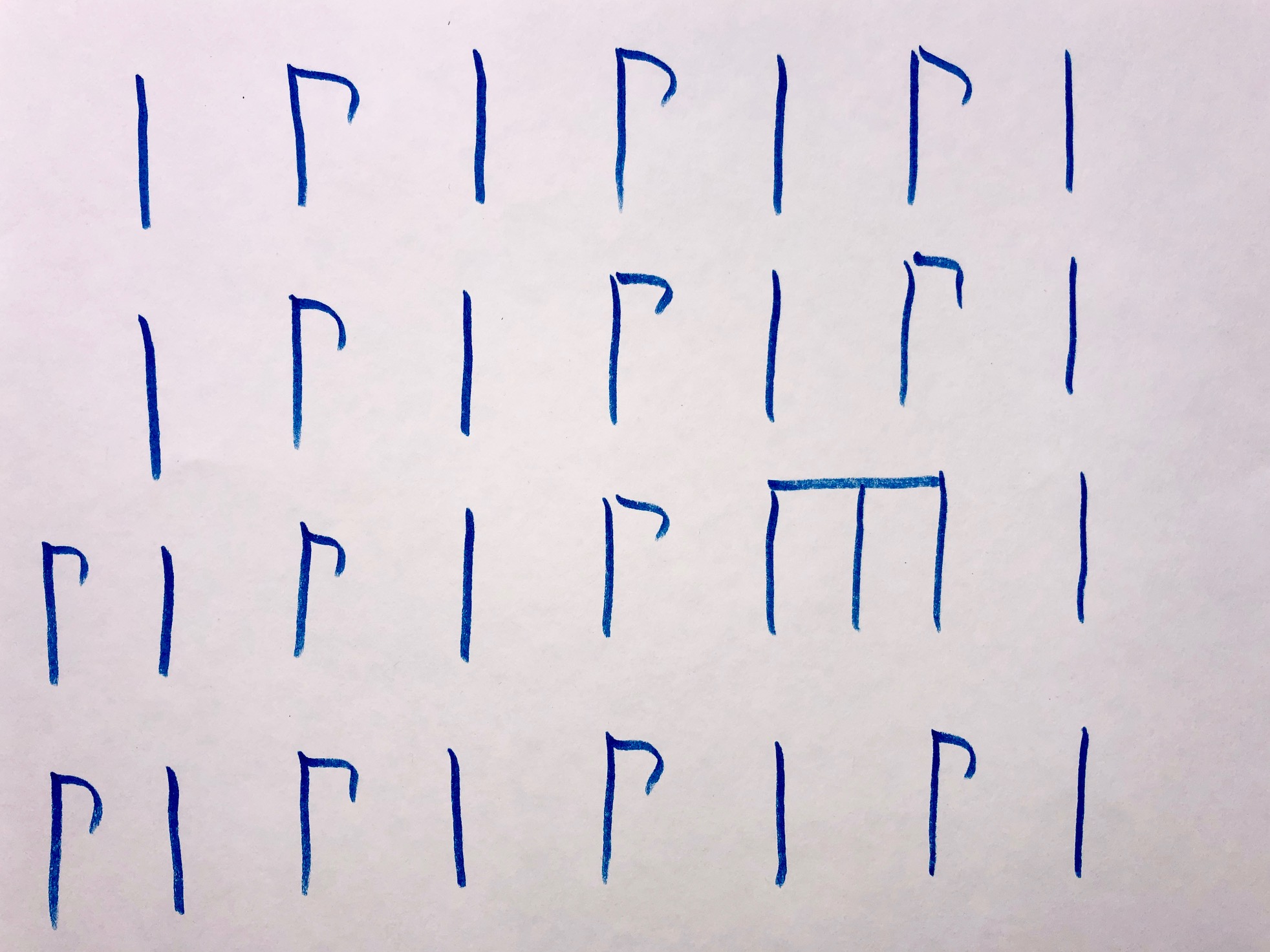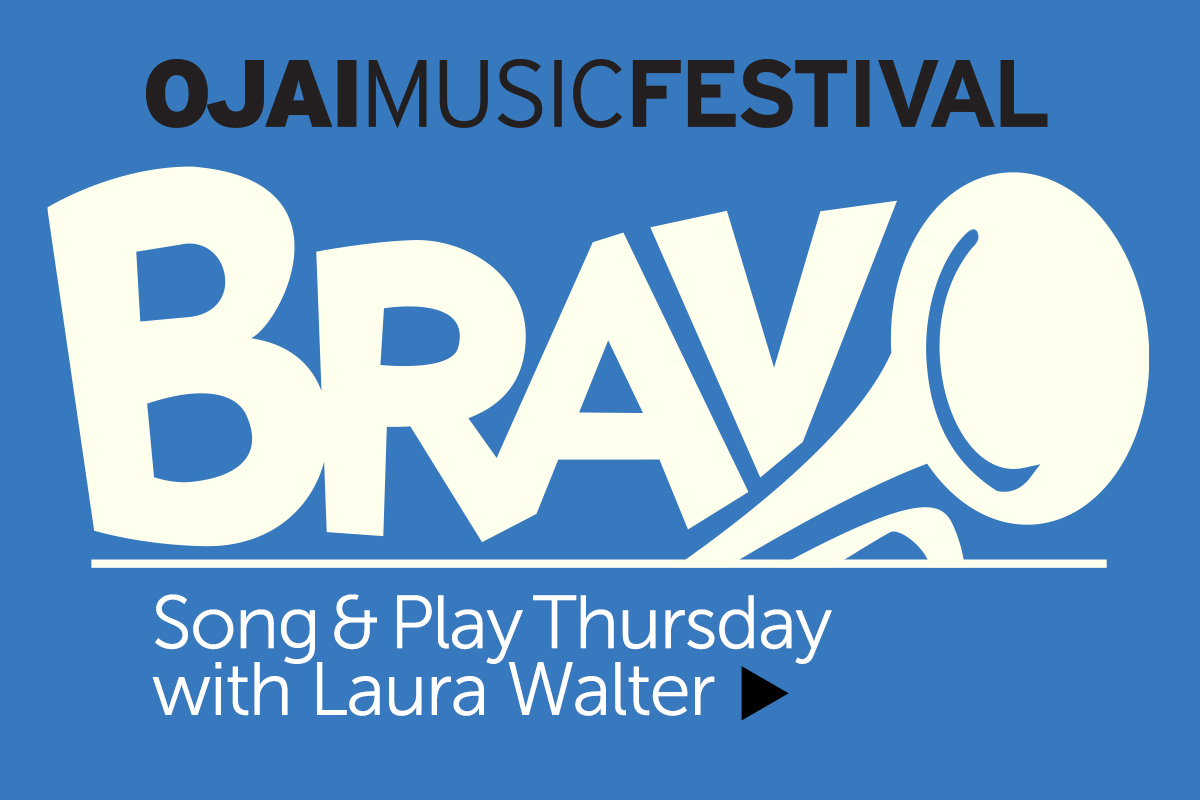Click on tabs below this video to view weekly music lessons.
- Introduction
- Meet Ms. Laura!
- Lesson 1, 4/16/20
- Lesson 2, 4/23/20
- Lesson 3, 4/30/20
- Lesson 4, 5/7/20
- Lesson 5, 5/14/20
- Lesson 6, 5/21/20
- Lesson 7, 5/28/20
- Lesson 8, 6/5/20
Introduction
The Festival’s BRAVO music education and community proudly presents Song & Play Thursday, led by Laura Walter, the Festival’s education coordinator.
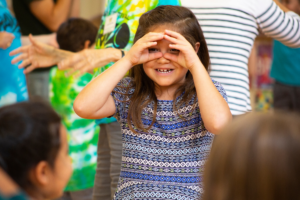
Based on the nationally well-regarded curriculum of Education Through Music, the short videos will provide children and families a language based music program in which song, movement and interactive play promote emotional, social, cognitive and musical development. Each week, the videos and curriculum notes will be available for free on the Festival’s website.
These song experience games are designed to improve listening skills, memory, and critical thinking. Singing releases endorphins. Play increases intelligence. These video sessions are an extension of what the Ojai Music Festival’s BRAVO program offers in all of the Ojai classrooms with Transitional Kindergarten through 3rd grade during the school year.
BENEFITS OF SONG & PLAY
- Develop eye contact
- Enrich functional vocabulary and language skills
- Interpret the written symbols in music helps with reading skills
- Activities are designed to be so fun that children are not only excited to get a turn, but equally excited when someone else gets a turn
- Work our memory and our visual and movement centers
- Connects brain centers — imagination, sequencing, and spatial memory
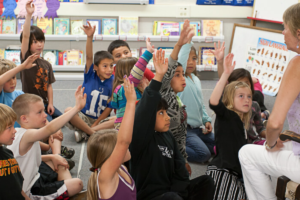 Ours is a program based on play, defined as the psychological state of flow or creativity. We get absorbed in what we are doing, and can’t wait to try it again. Our failures are seen as part of the fun. We sing partner songs and in canon, creating beautiful sounds ourselves. The children always ask if we can do that again! Community is so important for emotional growth, and these activities, help us stay connected.
Ours is a program based on play, defined as the psychological state of flow or creativity. We get absorbed in what we are doing, and can’t wait to try it again. Our failures are seen as part of the fun. We sing partner songs and in canon, creating beautiful sounds ourselves. The children always ask if we can do that again! Community is so important for emotional growth, and these activities, help us stay connected.
Special Thanks to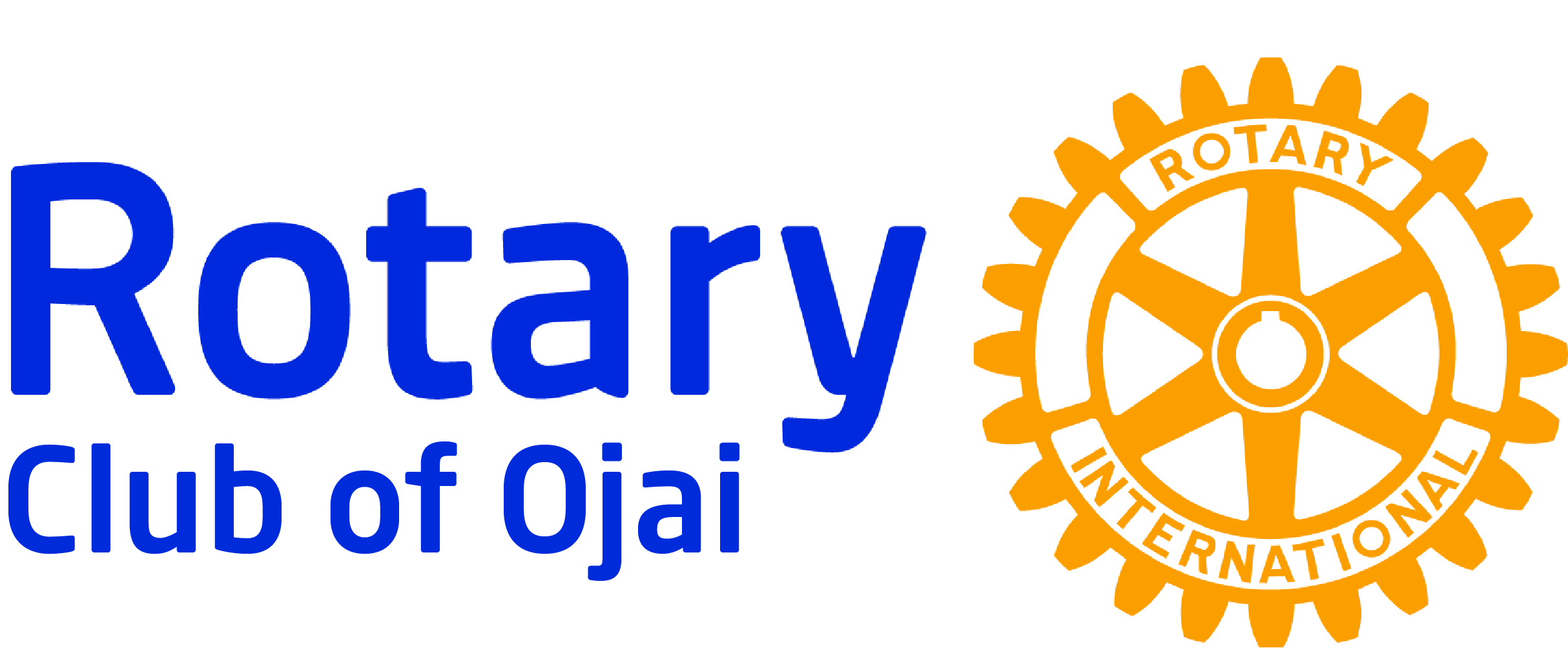
Meet Ms. Laura!
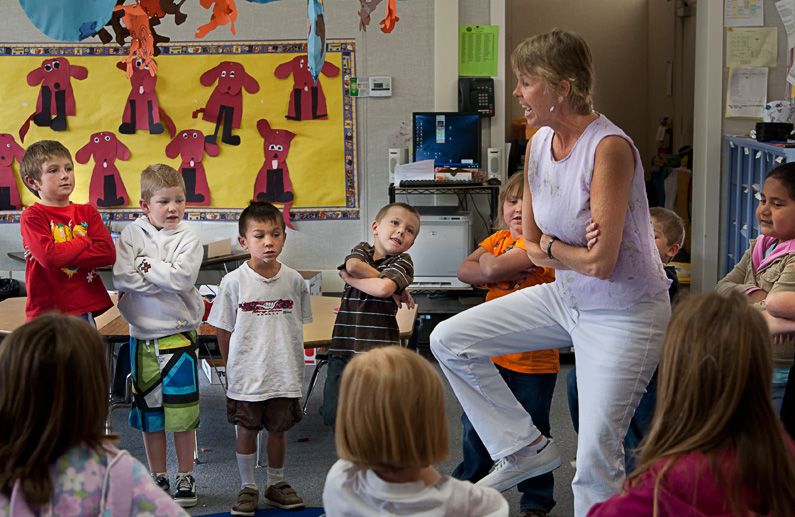 My name is Laura Walter and I am the Bravo Coordinator for the Ojai Music Festival. We are excited about our new, online videos. We’ll explore some secret songs, solfegge using hand signs, rhythmic patterns, and ideas for you to play with your own family. These song experience games of Education Through Music improve listening skills, memory, and critical thinking. Singing releases endorphins. Play increases intelligence.
My name is Laura Walter and I am the Bravo Coordinator for the Ojai Music Festival. We are excited about our new, online videos. We’ll explore some secret songs, solfegge using hand signs, rhythmic patterns, and ideas for you to play with your own family. These song experience games of Education Through Music improve listening skills, memory, and critical thinking. Singing releases endorphins. Play increases intelligence.
These video sessions are an extension of what I have played in all of the Ojai classrooms with Transitional Kindergarten through 3rd grade. We use a lot of eye contact. Giggling happens. And then it’s so interesting; our singing becomes stronger!
We move a lot. Our learning is active. We sing folk songs, which enrich functional vocabulary and language skills. Interpreting the written symbols in music helps children with reading skills. 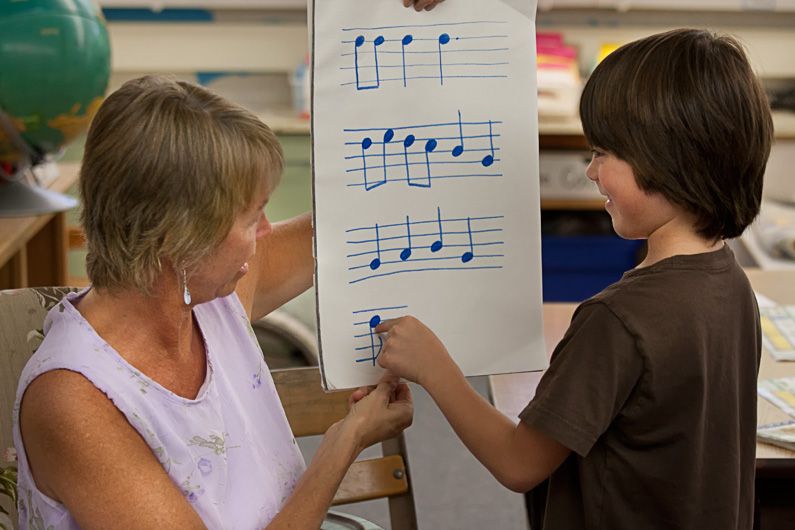
Community is so important for emotional growth. When we make music together, we improve self-regulation. Activities are designed to be so fun that children are not only excited to get a turn, but equally excited when someone else gets a turn!
When we puzzle over a secret song, our brains are looking for an auditory match, working our memory and our visual and movement centers. You will notice how good it feels to try to hear a secret song, after you know the answer. That’s because the activity connects brain centers—imagination, sequencing and spatial memory.
Ours is a program based on play, defined as the psychological state of flow or creativity. We get absorbed in what we are doing, and can’t wait to try it again. Our failures are seen as part of the fun. We sing partner songs and in canon, creating beautiful sounds ourselves. The children always ask if we can do that again!
Lesson 1, 4/16/20
Study the rhyming structure of this song and then make up your own. For instance, notice the underlined rhyming words below:
There’s a penny in my hand
It will travel through the land
Is it here, is it there?
It will travel everywhere.
To keep this rhyming scheme you might sing:
There’s a penny on this pier
It will travel without fear
Is it slim, can it swim?
It will travel on a whim.
If you email your own verses to us, I will sing them!
Send your verses to: [email protected]
These are some great student verses of Kitty Casket that we have sung and played in class. I appreciate the rhyming ideas! In class we looked at the difference between rhyming (end of the words sounding alike) and alliteration (words starting with like sounds). These are critical tools in fluency of reading.
Kitty Casket—the game. Pure delight! See how many you can get to join in!
Special Thanks To
Lesson 2, 4/23/20
We start with connecting and gathering our attention. The secret song represents the rhythm to a song the children have sung and played many times. By having the rhythm prompt, and then adding clues, we are causing the auditory system to look for a match in our memory. Penny is such a great song for playfulness, and being okay with not getting everything correct, which is so important for life success. Grab a penny and play! Feel free to print the rhythm page and follow, or add the words.
This childhood staple by Mozart is great fun to sing and play. Notice the clues that I give are concrete and words that they know; words that will spark a picture in their minds. This increases memory retrieval skills. When we play in the classroom, all eyes are closed while one child hides the star, leaving just one part visible. We must keep hope alive! They then choose a classmate to go look for it while we sing the song. They must be back by the end of the song. This skill of predicting when the song will end, (while being busy looking for it), is vital to reading fluency. They then pick a friend to go with them. This continues until the star is found. Some days the whole class has gone to look and they all have to be back by the end of the song. The song informs their behavior in this way, and they are completely self-monitoring without need of adults telling them what to do. The failure to find the star is never seen as a failure by the child, but rather as further effort, approached through play, and adding their friends. It’s really wonderful to see.
Local 3rd graders have been learning this cup song, and pairing it with the song of Uncle Joe. We have played the game of Uncle Joe for 4 months or so before I bring the cups out. The game is so enjoyable in itself, that to add the cups definitely has a *wow* factor!
Want to see a group of children engaged and happy to play cooperatively? Want to see the importance of movement in learning? Want to hear a group of 6 year-olds all singing in tune? Here they are! Every one of them has a sense of belonging and purpose in this class. Playing I Wrote a Letter encourages them to grow the social skill of being happy for someone else to get a turn. This is directly responsible for the strength of their singing, and their eventual synchronization of sound without any specific instruction about singing together from the teacher.
“I wrote a letter to my love and on the way I lost it.
A little doggie picked it up and put it in his pocket.
Oh, he won’t bite me and he won’t bite you, he’ll bite the one who’s got it.
So drop it, so drop it, it must be dropped by now.”
Lesson 3, 4/30/20
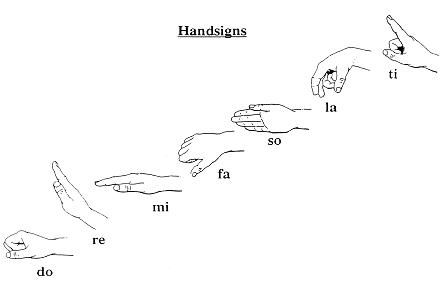 Children often know this song from singing around the campfire. The notes of the scale have corresponding hand signs: do, re, mi, fa, so, la and ti. These hand signs were developed by Sarah Glover in the 1700’s in England to help her choir members learn to read music. John Curwen popularized them, and Kodaly also integrated them into his teaching method. Often when we sing the songs, we use the hand signs to indicate the notes. We are learning about pitch relationships.
Children often know this song from singing around the campfire. The notes of the scale have corresponding hand signs: do, re, mi, fa, so, la and ti. These hand signs were developed by Sarah Glover in the 1700’s in England to help her choir members learn to read music. John Curwen popularized them, and Kodaly also integrated them into his teaching method. Often when we sing the songs, we use the hand signs to indicate the notes. We are learning about pitch relationships.
If you have family members at home, have them sit in a circle and if you want more, use some stuffed animals also! You can jump or skip together. This game has been around for generations. It’s a hoot to have a whole group skipping together. It gets the whole class excited. Because the song chooses their partner (when we sing the word “partner”), the students are always surprised with who they get. We are making our social circle bigger. When we sing this at the Gables of Ojai Senior Living, the residents remember this from their own childhoods, saying, “We are so happy that children still sing this song.” The proprioceptive experience gained from skipping with a partner aids in brain development, and crossing the midline aids in the bi-hemispheric learning of the brain.
This song is often the first experience children have playing on an instrument. We approach this folk song through a story. Why did people not make signs to advertise what they were selling? How did people sweeten their food 1,000 years ago? What was the importance of singing in the streets? We also add the hand signs for the music notes.
In our classrooms, we use children to stand in for the sun, the moon, and the chimney pot. We challenge ourselves to skip around them. Sometimes they are sneaky and change positions. We also try to get back to our spot by the end of the song; the “boom”. As our actions and movements line up with the beginning and ending of the song, we are practicing the reading skill of paying attention to the points of enclosure. Actions and sounds coincide and lead us to meaning.
Lesson 4, 5/7/20
This week we take a look at learning to read notes, singing our names to study rhythm, and looking at some children’s maps. We also include a video showing the engagement of children from Day 1.
Our first music class of the year. This is how I meet the children, by finding out their names and asking for their ideas. Listen to the enthusiasm of their singing right from the first day! Notice the kindness used as guidance for self-control.
Knowing each other’s names is one of the most honoring actions that we can take. We sing about our names! We study the rhythm and accents of the names. This is a musical skill, as well as a reading skill. Having a strong auditory system is important for reading, music, and listening.
Once we have played the game and gotten our bodies moving and involved, we take a look at the Tracks for Reading which includes different verses. The melody stays the same. This helps immensely in reading, because the beginning reader can still follow along on the map. New words overlay the same tune, making it familiar. The grammar also retains the same structure and helps with comprehension. It’s a wonderful way to boost reading skills! These books can be found online at the Richards Institute of Education and Research.
We really enjoy making our own maps of the songs. The children create their own abstract representation of the song. We notice patterns together. We practice drawing in the air first. Any pattern is correct because it is that person’s version of the song. This toggling back and forth between abstract and concrete is not only healthy for the brain, the students are delighted and completely absorbed in doing it. Singing the song is concrete, drawing in the air is abstract, putting it on paper makes it concrete with abstract ideas, singing it from their map makes it concrete again, following someone else’s map is abstract until it is concrete again. This is the process of reading music, which is, after all, an abstract representation of sound.
We love matching our note of the day to the scale above and trying to find the note’s name. We pretend it’s an amazing secret, which cracks us all up while everyone wants to make a guess, so they whisper it!
Lesson 5, 5/14/20
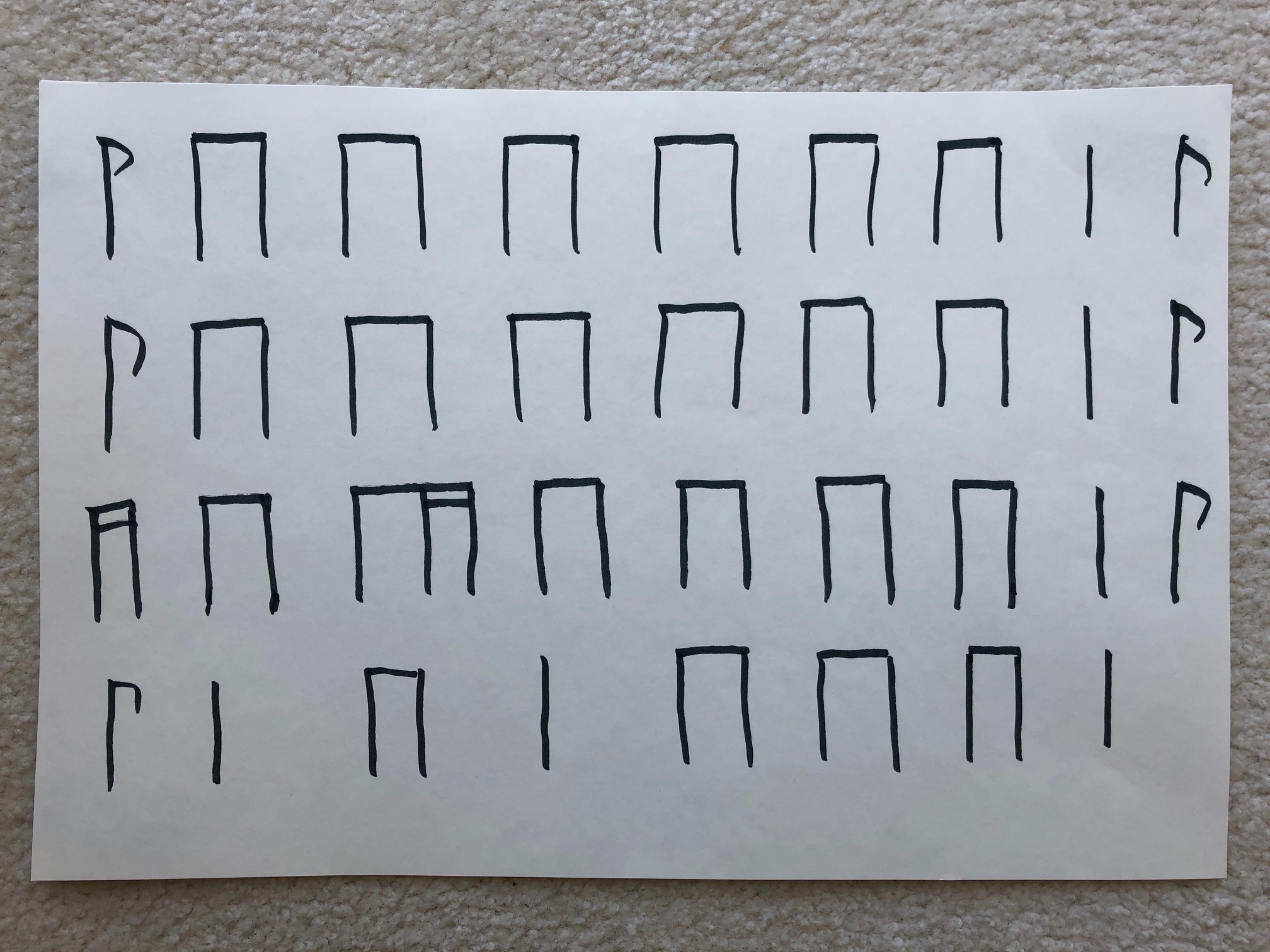 Playing this game is one of our favorites. We sit in a circle and one child drops a letter while we hide our eyes. The chosen child gets up and chases the letter dropper. What this song game does for children is pretty incredible—we start to enjoy another’s turn just as much as getting one ourselves. Here we learn empathy through play. We often turn to a rhythmic representation of the song (find here), and discover the different sounds by adding body movements for distinct rhythmic notes.
Playing this game is one of our favorites. We sit in a circle and one child drops a letter while we hide our eyes. The chosen child gets up and chases the letter dropper. What this song game does for children is pretty incredible—we start to enjoy another’s turn just as much as getting one ourselves. Here we learn empathy through play. We often turn to a rhythmic representation of the song (find here), and discover the different sounds by adding body movements for distinct rhythmic notes.Haircut Stuffies
Lesson 6, 5/21/20
Today we look at the importance of memory in learning, and the importance of play in building intelligence.
Secret song Haircut + Rhythm Page
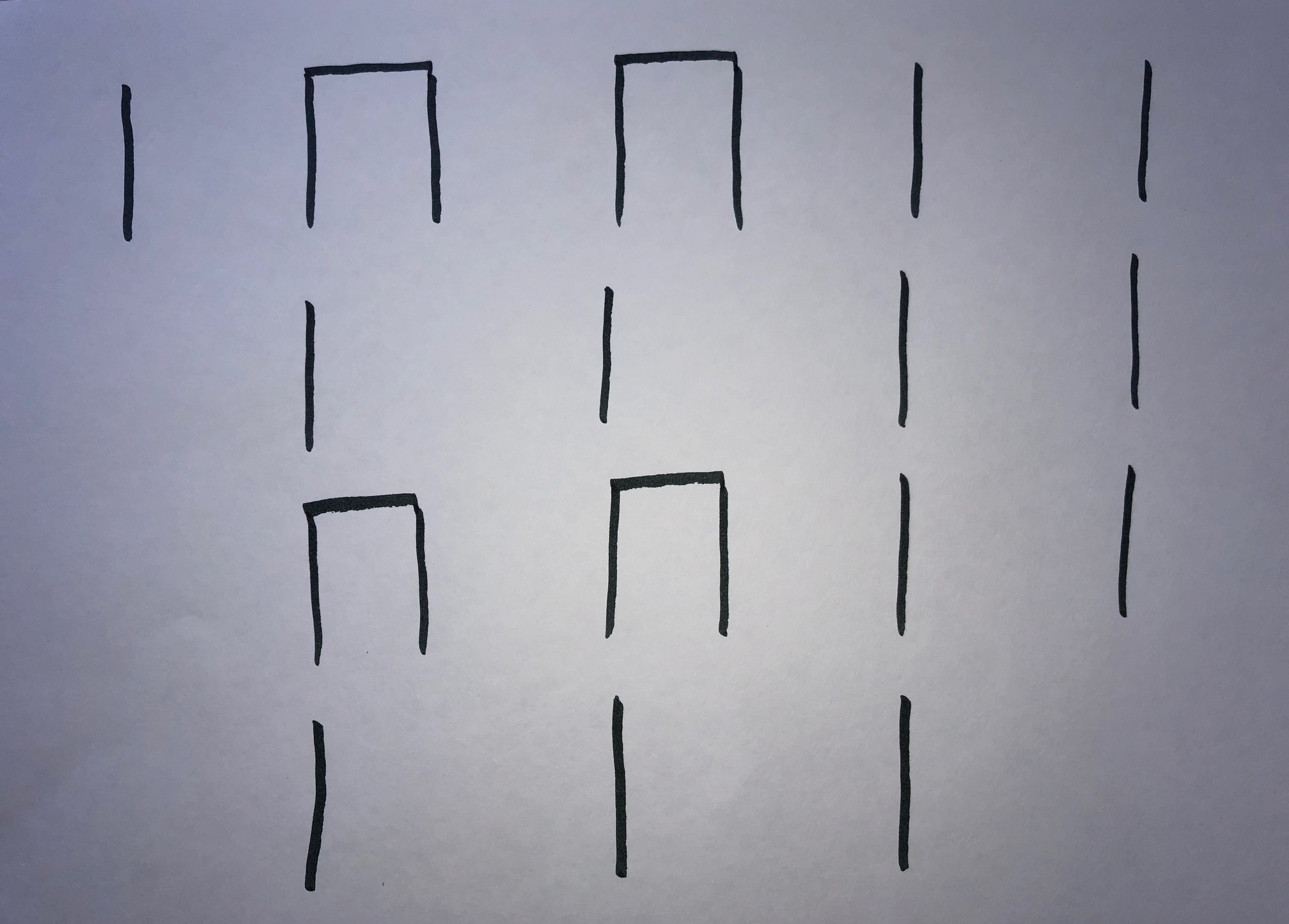
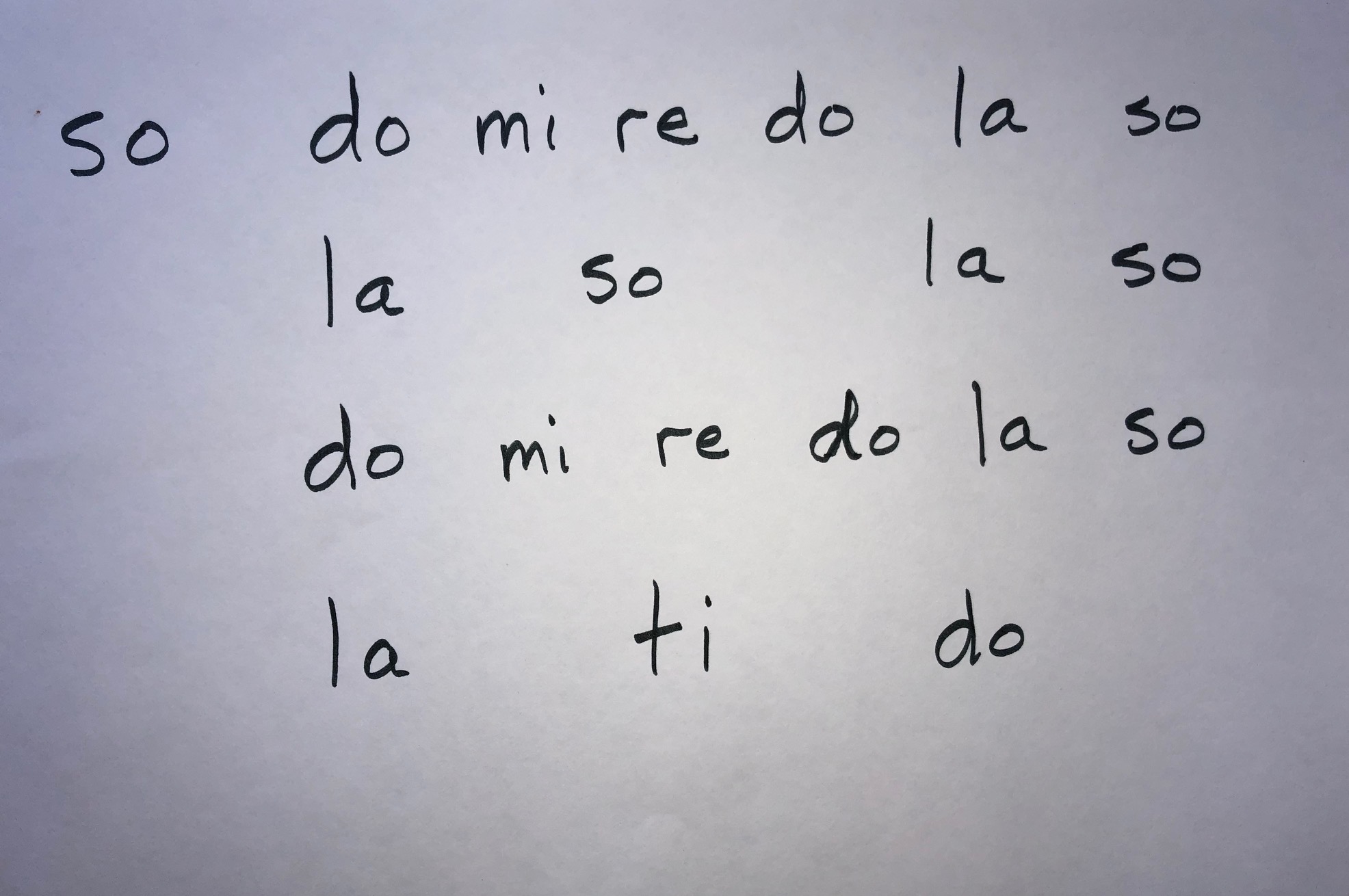
After the students have sung and played this game, so much that it is internalized and accessed automatically, we present it as a secret song. We don’t want to ask the brain to do this too soon, but only after lots of play and sensory experience. Then the secret part of puzzling over it is enjoyable, and do-able. The brain starts searching its memory banks for a match. When the memory is engaged, learning is happening. We easily translate the song into its rhythms. Since we have the melody, we can now learn the solfegge syllables (do, re, mi, etc.) as well. Going back and forth between words, rhythm, and solfegge keeps the brain hopping and the kids love doing this!
Haircut Videos
In music, we want to build 3 habits in children: cooperation, participation, and the habit of singing. Here are some at-home examples of families playing Johnny Get Your Haircut.
Bluebird
We have birds and windows all over the place. We can have windows made out of our legs, and birds trying to navigate through and under. This sensory experience of the song is stored in more brain areas for easier retrieval. We want our learning to be multi-modal: auditory, visual, kinesthetic, and tactile. A robust memory aids in the development of intelligence.Note of the Day—C
The challenge grows as we rely on our shortcut and don’t have the “scale” up for reference anymore!Lesson 7, 5/28/20
There are many different methods of symbolizing sound. The process of interpreting symbols, semiotic function, is important for reading, math, and music. This week we also notice how we build resiliency—the balance between challenge and skill, always with an eye towards pro-social behaviors of inclusivity, kindness, taking turns, and the opportunity to be moved by shared experience instead of external rewards.
Video 4:53 One Little Elephant
Bluebird Form and Map
It is quite enjoyable to match up a written symbol with a corresponding sound. Noticing patterns is what the brain loves to do! Here we take a look at the beat and the various ways to explore that. We can have a slow, medium, or fast beat while the tempo of the song stays the same. These form books are available through the Richards Institute of Education and Research.
Frog
When I have the room set up for Frog’s in the Meadow, the children walk in and instantly know what song game we are going to play. I hear squeals of delight! One child becomes the frog and does the hiding while everyone sings. I change the starting pitches often, which provides ear training without stress. Their voices automatically adjust to singing in tune this way. In older grades we have up to 5 frogs hiding at once. Finding the frogs relies on deductive reasoning and memory. As guesses are made, we get to keep track of where there are no frogs. The play here is many-faceted. The brain is wired to explore playing with object permanence in both sound (music) and vision (art). Having a shared puzzle, trying to find the frogs, increases bonding, attachment, and belonging.Secret Song Letter
Another way to play with the symbols of a song is to put some notes into our hands and sing the solfege, but the rest of the words in English. This great challenge is enjoyable because it is almost achievable—this is the aspect of play called perceived competency; I think I can get it if I try one more time. We then have internal motivation and participation that comes from inside the person. No rewards are used other than the experience itself. We are symbolizing the sound in two distinct languages by toggling back and forth quickly!Note of the Day
One reason music education is so important to the brain is that learning to read music adds a layer of abstract symbolization. In learning to read the printed word in a language, the brain is required to connect what it sees with a sound it has heard before. And in order to have meaning, this sound must represent something concrete that has been experienced (the letters, c, a , t, how they sound when combined, and what a cat is). In learning to read music, we see the note “D”, we know what it is called and perhaps can play it on an instrument, but it doesn’t represent a concrete thing besides the sounding of itself. It gains meaning when combined with notes that surround it, making a melody.Lesson 8, 6/5/20
Bombalalom
Our Bombalalom place is where we feel peaceful. As we sing this song, we reflect on how important it is to listen to each other, that we cooperate with each other, that we accept each other. There are times when we feel bad, and it’s okay to feel that way. We ask each other “how can we help?” We want to use our voice to make the future, and the present, better. Let us listen deeply.Elephant in 3s
Aesthetics show up in many forms—visual art, sounds in music, the beauty of communication, or joy of movement. Here we have the aesthetic of thinking. Students brighten up when faced with this challenge. By providing a variety of aesthetic experiences, we really do reach all children through including them by invitation.Mozart Canon
Here are some fun facts about Mozart! We have been learning this Canon (a piece of music that is repeated at different intervals to create harmony) all year long. Bravo students love coming up to try their hands at leading this. I ask them if they want it with me or without me. They get very brave! Then they want it harder, and I start on a different part. It just gets better and better!Secret Song
One way the brain builds the ability to empathize, is through mirror neurons. These are activated when we are united in song, or moving together. What looks from the outside to be a minor challenge, is actually doing some deeper tissue work in helping children become more empathetic and therefore, compassionate.Oats Peas Beans-nouns and verbs
We take a look at language through singing, exploring nouns and verbs in a playful way. The children love discovering a secret song, so I thought I would give them this added challenge—where is that song? Feel free to print it out and try to follow it yourself! This is a song about planting, and the summer is a wonderful time to get outside and plant things. Get your hands in the dirt. It’s very nurturing.